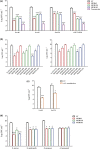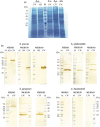Bactericidal fully human single-chain fragment variable antibodies protect mice against methicillin-resistant Staphylococcus aureus bacteraemia
- PMID: 34221401
- PMCID: PMC8240403
- DOI: 10.1002/cti2.1302
Bactericidal fully human single-chain fragment variable antibodies protect mice against methicillin-resistant Staphylococcus aureus bacteraemia
Abstract
Objectives: The increasing prevalence of antibiotic-resistant Staphylococcus aureus, besides the inadequate numbers of effective antibiotics, emphasises the need to find new therapeutic agents against this lethal pathogen.
Methods: In this study, to obtain antibody fragments against S. aureus, a human single-chain fragment variable (scFv) library was enriched against living methicillin-resistant S. aureus (MRSA) cells, grown in three different conditions, that is human peripheral blood mononuclear cells with plasma, whole blood and biofilm. The antibacterial activity of scFvs was evaluated by the growth inhibition assay in vitro. Furthermore, the therapeutic efficacy of anti-S. aureus scFvs was appraised in a mouse model of bacteraemia.
Results: Three scFv antibodies, that is MEH63, MEH158 and MEH183, with unique sequences, were found, which exhibited significant binding to S. aureus and reduced the viability of S. aureus in in vitro inhibition assays. Based on the results, MEH63, MEH158 and MEH183, in addition to their combination, could prolong the survival rate, reduce the bacterial burden in the blood and prevent inflammation and tissue destruction in the kidneys and spleen of mice with MRSA bacteraemia compared with the vehicle group (treated with normal saline).
Conclusion: The combination therapy with anti-S. aureus scFvs and conventional antibiotics might shed light on the treatment of patients with S. aureus infections.
Keywords: bacteraemia; bactericidal antibodies; fully human antibody; methicillin‐resistant Staphylococcusaureus; single‐chain fragment variable.
© 2021 The Authors. Clinical & Translational Immunology published by John Wiley & Sons Australia, Ltd on behalf of Australian and New Zealand Society for Immunology, Inc.
Conflict of interest statement
The authors declare that they have no conflict of interest.
Figures








Similar articles
-
Development and identification of fully human scFv-Fcs against Staphylococcus aureus.BMC Immunol. 2016 Apr 29;17(1):8. doi: 10.1186/s12865-016-0146-z. BMC Immunol. 2016. PMID: 27129873 Free PMC article.
-
A novel fully human recombinant antibody neutralizing α-hemolysin of Staphylococcus aureus.APMIS. 2022 Sep;130(9):578-589. doi: 10.1111/apm.13258. Epub 2022 Jul 12. APMIS. 2022. PMID: 35751523
-
Oxiconazole Potentiates Gentamicin against Gentamicin-Resistant Staphylococcus aureus In Vitro and In Vivo.Microbiol Spectr. 2023 Aug 17;11(4):e0503122. doi: 10.1128/spectrum.05031-22. Epub 2023 Jul 10. Microbiol Spectr. 2023. PMID: 37428033 Free PMC article.
-
How I manage a patient with MRSA bacteraemia.Clin Microbiol Infect. 2022 Feb;28(2):190-194. doi: 10.1016/j.cmi.2021.10.014. Epub 2021 Oct 29. Clin Microbiol Infect. 2022. PMID: 34757117 Review.
-
A comparative assessment of clinical, pharmacological and antimicrobial profile of novel anti-methicillin-resistant Staphylococcus aureus agent levonadifloxacin: Therapeutic role in nosocomial and community infections.Indian J Med Microbiol. 2019 Oct-Dec;37(4):478-487. doi: 10.4103/ijmm.IJMM_20_34. Indian J Med Microbiol. 2019. PMID: 32436868 Review.
Cited by
-
Anti-Acinetobacter Baumannii single-chain variable fragments provide therapeutic efficacy in an immunocompromised mouse pneumonia model.BMC Microbiol. 2024 Feb 10;24(1):55. doi: 10.1186/s12866-023-03080-9. BMC Microbiol. 2024. PMID: 38341536 Free PMC article.
-
Identification of a novel fully human anti-toxic shock syndrome toxin (TSST)-1 single-chain variable fragment antibody averting TSST-1-induced mitogenesis and cytokine secretion.BMC Biotechnol. 2022 Oct 28;22(1):31. doi: 10.1186/s12896-022-00760-8. BMC Biotechnol. 2022. PMID: 36307814 Free PMC article.
-
The Potential of Single-Chain Variable Fragment Antibody: Role in Future Therapeutic and Diagnostic Biologics.J Immunol Res. 2024 Aug 9;2024:1804038. doi: 10.1155/2024/1804038. eCollection 2024. J Immunol Res. 2024. PMID: 39156005 Free PMC article. Review.
-
Anti-Acinetobacter baumannii single-chain variable fragments show direct bactericidal activity.Iran J Basic Med Sci. 2022 Sep;25(9):1141-1149. doi: 10.22038/IJBMS.2022.64062.14106. Iran J Basic Med Sci. 2022. PMID: 36246061 Free PMC article.
-
Identification of two neutralizing human single-chain variable fragment antibodies targeting Staphylococcus aureus alpha-hemolysin.Iran J Basic Med Sci. 2022 Oct;25(10):1207-1214. doi: 10.22038/IJBMS.2022.64103.14253. Iran J Basic Med Sci. 2022. PMID: 36311199 Free PMC article.
References
-
- Lowy FD. Staphylococcus aureus infections. N Engl J Med 1998; 339: 520–532. - PubMed
-
- Lehar SM, Pillow T, Xu M et al. Novel antibody–antibiotic conjugate eliminates intracellular S. aureus . Nature 2015; 527: 323–328. - PubMed
-
- Lee AS, de Lencastre H , Garau J et al. Methicillin‐resistant Staphylococcus aureus . Nat Rev Dis 2018; 4: 1–23. - PubMed
LinkOut - more resources
Full Text Sources
Molecular Biology Databases
